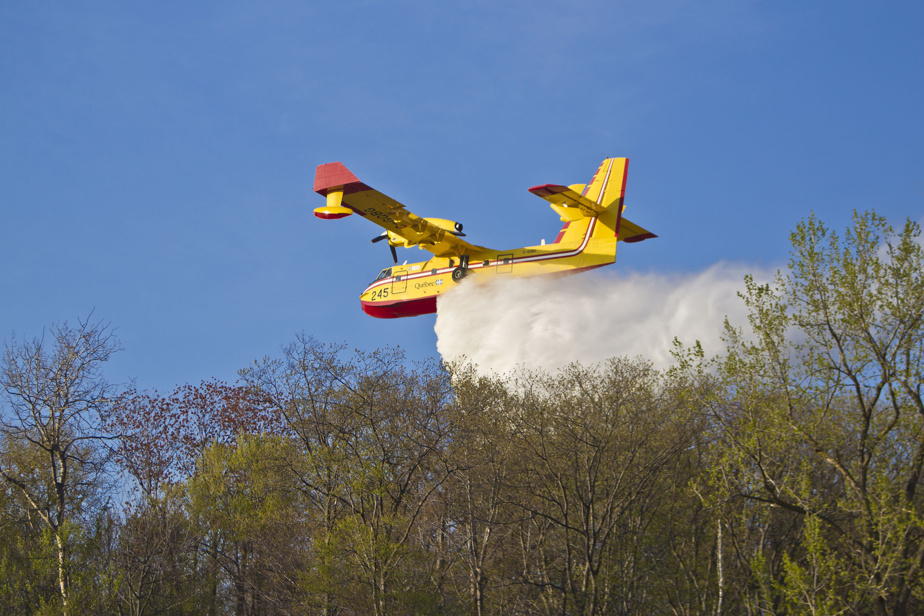Essential these days, the famous Canadair air tankers have never made buyers run. At several tens of millions of dollars for a copy, deliveries were made in dribs and drabs and production ceased in 2015 in Canada. Can this program take off again? A Toronto company believes in it.
“Theoretically, there is a market, but nobody wants to spend to buy the device, underlines the American analyst Richard Aboulafia, director of the firm AeroDynamics. That’s the frustrating thing: the design is perfect for the purpose. But it’s too tight. »
In the financial turmoil at the time, Bombardier made its last deliveries of amphibious aircraft in 2015 before selling the program – one of the most famous in Canadian aviation history – to a Toronto-based subsidiary of De Havilland. , the next year.
The Quebec company never delivered more than five examples of the Bombardier 415 in one year in the decade preceding the end of production.

At that time, this little yellow and red water bomber was selling for around 35 million, according to list prices. Added to this are the operating costs – fuel, pilot training and annual maintenance – which amounted to 2 million, according to an estimate made in 2013 by the Rand Corporation, a firm which advises the American army.
“You don’t make millions out of it,” says aviation expert and McGill University lecturer John Gradek. It’s a specialized niche. »
The question is: can this device be produced profitably? This is the challenge before us. One or two deliveries a year cannot sustain the program.
John Gradek, aviation expert
Recognized worldwide in the fight against forest fires, Canadair’s CL-215 entered service in 1960 before being replaced by the CL-415 in 1994. These devices need only 12 seconds to accumulate between 5000 and 6000 liters of water while skimming the surface of a lake or ocean at high speed.
There are few competitors capable of performing the same tasks as the Canadairs. Companies like Air Tractor and Thrush Aircraft build agricultural work planes that can also fight wildfires. Commercial aircraft such as the converted McDonnell Douglas DC-10 were also introduced into service, but there are only a few.

PHOTO PROVIDED BY US FOREST SERVICE
A McDonnell Douglas DC-10 converted to fight forest fires
These options are less expensive, however, according to Mr. Aboulafia.
“It’s a question of price, quite simply, says the American analyst. The problem [des Canadair] is the competition. In the United States, it’s on the verge of madness, we use 50-year-old planes that we modify. »
Old Canadair
Quebec has 14 aircraft, including 8 cl-415. Expanding the current fleet could be accompanied by a bill of several hundred million if one wishes to acquire newer models.
There is also another obstacle: the next deliveries will not take place before 2026 and 2027. Moreover, it is mainly European customers who will receive these tanker planes. After years of work, De Havilland is preparing to restart production of these devices, renamed DHC-515, in Calgary. They will continue to be equipped with propeller engines (PW100) built by Pratt & Whitney Canada in Longueuil. According to Mr. Gradek, the price of a copy could well be around 60 million – well beyond that of a CL-415.
“We think the market [mondial] is a few hundred planes,” says De Havilland vice-president of programs, Jean-Philippe Côté.
We believe we have realistic delivery targets. The phone is ringing more and more at home. Countries that have never operated air tankers are interested in it.
Jean-Philippe Côté, Vice-President of Programs De Havilland
Despite the production interruption, Canadian expertise in the field has not gone away, assures Mr. Côté. De Havilland can always “find solutions” to obtain the missing parts in order to carry out the maintenance of the CL-215 and CL-415. Without going so far as to say that his government intended to buy new tanker planes, Prime Minister François Legault mentioned, earlier this week, the difficulties in terms of maintenance for older aircraft.
“It is certain that when we are talking about copies that are 40 or 50 years old, sometimes the original supplier no longer exists,” underlines Mr. Côté. We can put solutions in place to make a new design. Our priority is to ensure that the existing fleet can fly. »
De Havilland also offers a facelift to owners of the first generation of devices. This is another example that testifies to the maintenance of expertise, believes the vice-president of the company.
“This is a project that typically takes a year,” explains Mr. Côté. It really is a refurbishment. We open the structure, the wing, we inspect and we make sure that the whole system is up to date. »
The Quebec government has four CL-215s and two CL-215Ts.
The story so far:
1966: Quebec orders 20 cl-215. The French government is following suit by buying 10 devices.
1994: Bombardier redesigns the CL-215 and decides to rename it CL-415.
2016: The Quebec aircraft manufacturer sells the amphibious aircraft program to Viking Air, a subsidiary of De Havilland.
2022: De Havilland unveils its DHC-515, its next-generation air tanker.
Learn more
-
- 160
- This is the number of Canadair air tankers in service in 10 countries. There are about 60 in Canada.
dehavilland
